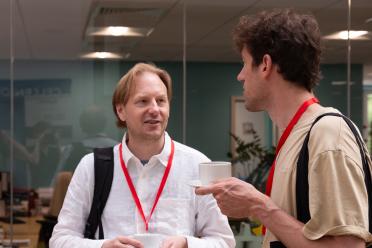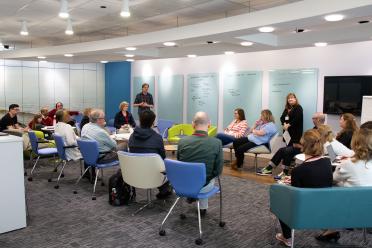Every cell tells a story: single-cell analysis in forensic science
DNA analysis has transformed forensic science - but interpreting mixtures of DNA from multiple individuals can be a challenge. Could single-cell analysis help?
As we move through the world, we leave countless traces behind us. Our bodies shed cells constantly; we lose an astounding 200 million skin cells every hour. Cells containing our DNA can be found in all of our body fluids, shed hairs and on surfaces we have touched.
Understanding how our bodies leave DNA traces is fundamental to forensic science. If we were able to track every cell we have left behind, it would paint a very clear picture of where we have been and what we were doing.
And when crimes were committed with multiple people present, we’d be able to see clear evidence of who was where - and gain insight into exactly what they did.
However, it isn’t possible to track every cell the body loses. And the human body’s habit of shedding means - when it comes to crime - forensic investigators often face issues with mixed samples.
A high proportion of crime scene DNA samples in the UK criminal justice system are believed to contain genetic material from two or more people. Yet traditional analytical techniques often struggle to separate the individual contributors.
For example, if someone handles an object - leaving skin cells on it - and then, later, another person gets blood on the same object - there is potential an investigator could identify the blood as belonging to the first individual.
This makes it harder for investigators to search DNA databases, or accurately reconstruct a sequence of events. But recent advances in single-cell genomics could offer a breakthrough.
Over the past decade, methods for cell analysis have rapidly evolved. Scientists are now able to study the genetic material of individual cells. These techniques are already widely used in fields such as cancer research and developmental biology.
And a new research initiative led by the Earlham Institute - Single-cell and single molecule analysis for DNA identification (SCAnDi) - is applying them to forensics.
Traditionally, DNA analysis involves looking either at averaged data from a large population of cells, or analysing a single isolated sequence in detail.
However, there is a middle ground between these two extremes. Studying behaviour at the level of individual cells is a powerful tool. This approach can give insights into genetic variation between cells and the complex interplay between genes and proteins.
Single-cell genomic technologies have advanced rapidly in the last decade, with an array of approaches for analysis and visualisation of individual cells.
The Earlham Institute’s single cell and spatial analysis team has developed and established tools and platforms which read out genomic information from a single cell. The group also continues to integrate new approaches – such as long-read sequencing – into single-cell workflows.

Dr Iain Macaulay (left) Group Leader in single-cell and spatial genomics at the Earlham Institute and Project Lead for SCAnDi
Research that advances technology development for forensic science is incredibly important for the continued improvement of the accuracy of forensic investigations. This week, a report from the All-Party Parliamentary Group on Miscarriages of Justice has found the UK's forensic science sector is in serious decline.
The Westminster Commission on Forensic Science used evidence gathered from public and professional responses, multiple Parliamentary sessions, and site visits to labs in the UK and the Netherlands.
The report makes more than 30 recommendations, including creating a National Forensic Institute and a national research strategy for forensic science, bringing together forensic academics, researchers, industry and police to foster a renewed culture of innovation and development in the sector.
The SCAnDi project is led by Dr Iain Macaulay, Technical Development Group Leader at the Earlham Institute. Dr Macaulay has just presented the initial findings of the team at the European Academy of Forensic Sciences conference in Dublin.
“We’re currently working on mixtures of cells from different individuals to see whether we can accurately assign a single cell to the correct individual using known DNA profiles,” he says.
“We are also starting to explore RNA profiling from the same cells, to infer cell type. Our goal here is not only to get a DNA profile from a single cell, but also to understand what kind of cell it was. Context matters a lot in forensic science. It’s not just about whose DNA is present, but how it got there.
“For instance, if a sperm cell is found, it suggests a different scenario than the same DNA from a skin cell. Knowing both who the DNA belongs to, and what type of cell it came from, can help reconstruct events.”
He emphasises that single-cell technologies hold significant potential for forensic science. These approaches could fill critical gaps in current forensic capabilities - especially for complex or contaminated samples.
“The issue of DNA transfer and mixtures is a central problem for forensics. Any technique that can clarify the source or context of DNA in complex mixtures is potentially very powerful.
“Collaboration is going to be key moving forward. We’ve held a number of stakeholder events where we’ve had the opportunity to work towards co-development of a single-cell strategy that would be compatible with the UK justice system. We’re always expanding our network and we are keen to connect with other researchers working on similar challenges.”

The SCAnDi project team at a workshop meeting in 2024
Dr Macaulay is working with co-investigators from the James Hutton Institute, the University of Portsmouth, the University of Derby, Liverpool John Moores University, Edge Hill University, and the University of Edinburgh.
The multidisciplinary team has expertise in single-cell genomics, DNA profiling, microfluidics, artificial intelligence, and forensic genetics.
A key component of SCAnDi is its engagement with the criminal justice sector. The team has established a network of forensic practitioners, legal representatives, researchers, and commercial suppliers and is consulting them to ensure the work meets the real-world needs of forensic investigators.
SCAnDi is hosted at the Earlham Institute, which provides world-class infrastructure through the BBSRC National Bioscience Research Infrastructure in Transformative Genomics.
This includes specialist platforms for cell sorting, genomics, and automation, supported by the Biotechnology and Biological Sciences Research Council (BBSRC), also part of UKRI.
The project was initially funded for a year, from April 2024, by the Economic and Social Research Council (ESRC), part of UKRI. It has been extended to March 2026.
Sign up to receive our monthly newsletter